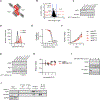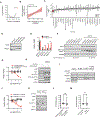Selective Modulation of a Pan-Essential Protein as a Therapeutic Strategy in Cancer
- PMID: 33883167
- PMCID: PMC8419012
- DOI: 10.1158/2159-8290.CD-20-1213
Selective Modulation of a Pan-Essential Protein as a Therapeutic Strategy in Cancer
Abstract
Cancer dependency maps, which use CRISPR/Cas9 depletion screens to profile the landscape of genetic dependencies in hundreds of cancer cell lines, have identified context-specific dependencies that could be therapeutically exploited. An ideal therapy is both lethal and precise, but these depletion screens cannot readily distinguish between gene effects that are cytostatic or cytotoxic. Here, we use a diverse panel of functional genomic screening assays to identify NXT1 as a selective and rapidly lethal in vivo relevant genetic dependency in MYCN-amplified neuroblastoma. NXT1 heterodimerizes with NXF1, and together they form the principal mRNA nuclear export machinery. We describe a previously unrecognized mechanism of synthetic lethality between NXT1 and its paralog NXT2: their common essential binding partner NXF1 is lost only in the absence of both. We propose a potential therapeutic strategy for tumor-selective elimination of a protein that, if targeted directly, is expected to cause widespread toxicity. SIGNIFICANCE: We provide a framework for identifying new therapeutic targets from functional genomic screens. We nominate NXT1 as a selective lethal target in neuroblastoma and propose a therapeutic approach where the essential protein NXF1 can be selectively eliminated in tumor cells by exploiting the NXT1-NXT2 paralog relationship.See related commentary by Wang and Abdel-Wahab, p. 2129.This article is highlighted in the In This Issue feature, p. 2113.
©2021 American Association for Cancer Research.
Figures





Comment in
-
mRNA Export as a Novel Cancer-Specific Dependency.Cancer Discov. 2021 Sep;11(9):2129-2131. doi: 10.1158/2159-8290.CD-21-0862. Cancer Discov. 2021. PMID: 34479974
References
-
- Behan FM, Iorio F, Picco G, Gonçalves E, Beaver CM, Migliardi G, et al.Prioritization of cancer therapeutic targets using CRISPR-Cas9 screens. Nature. 2019;568:511–6. - PubMed
Publication types
MeSH terms
Substances
Grants and funding
LinkOut - more resources
Full Text Sources
Other Literature Sources
Medical
Research Materials

